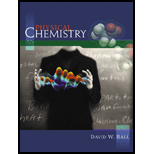Sorry! We don’t have solutions for this edition yet.
Solutions are available for other editions of this book
View 2nd Edition solutionsarrow_forwardBook Details
Intended for the year long, calculus-based physical chemistry course for science and engineering majors, PHYSICAL CHEMISTRY follows a traditional organization while concentrating on core topics. The text does not cover some higher level topics for example, photochemistry, molecular beams, thermal physics, and polymers found in some textbooks, and rarely covered in the undergraduate physical chemistry course, but more fully explains the essential elements of the discipline. Written by a dedicated chemical educator and researcher, this text is intended for those students who are trying to learn physical chemistry a book that works as a textbook and not as an encyclopedia. Where appropriate, there is some focus on mathematical manipulations, providing students with a review of calculus applications as applied to physical chemistry.
Benefits:
- Chapter 9, "Pre-Quantum Mechanics," a unique preview to Quantum Mechanics, allows students to develop a better understanding of the importance, conclusions, and necessity of the subject by putting the state of classical science into a historical context.
- Answers to selected exercises are included in an appendix.
- Both an Instructor's Manual with solutions and a Student Solutions Manual complement the text.
- The text covers the core concepts of physical chemistry in great detail, foregoing coverage of topics rarely covered in an undergraduate physical chemistry course.
- A dynamic, two-color art and photo program fully complements the text and visually reinforces students' conceptual understanding.
- Each chapter is introduced by a uniquely placed "chapter summary" which provides a synopsis of what the chapter will cover, where the material will take them, and why.
- A large number of "worked examples" of varying difficulty are integrated throughout the text to promote students' understanding of concepts and the development of chemical problem solving skills. In many cases, examples then serve as models for solving the end-of-chapter problems.
- Although there are some mathematical derivations among the exercises, most exercises have been created with an emphasis on asking students to use the concepts, rather than just derive them. Because of the text's emphasis on understanding physical chemistry concepts, many examples are conceptual in nature. An equal emphasis is placed on both units and numbers in examples and subsequent exercises and problems.
- End-of-chapter exercises and problems are separated by chapter section allowing for better coordination of chapter material with the problem.
- Over 1000 end-of-chapter exercises and problems provide students with ample opportunity to practice text concepts and test their mastery of the material.
- Some end-of-chapter exercises require the use of symbolic mathematical software (MathCad, Maple, or high-level calculator) to practice manipulations of the concepts. These more challenging problems require advanced skills and can be used as group assignments.
More Editions of This Book
Corresponding editions of this textbook are also available below:
